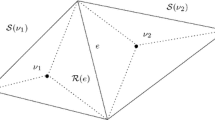Abstract
In [6], the Ghost Fluid Method (GFM) was developed to capture the boundary conditions at a contact discontinuity in the inviscid compressible Euler equations. In [11], related techniques were used to develop a boundary condition capturing approach for the variable coefficient Poisson equation on domains with an embedded interface. In this paper, these new numerical techniques are extended to treat multiphase incompressible flow including the effects of viscosity, surface tension and gravity. While the most notable finite difference techniques for multiphase incompressible flow involve numerical smearing of the equations near the interface, see, e.g., [19, 17, 1], this new approach treats the interface in a sharp fashion.
Similar content being viewed by others
REFERENCES
Brackbill, J. U., Kothe, D. B., and Zemach, C. (1992). A continuum method for modeling surface tension. J. Comput. Phys. 100, 335–354.
Chang, Y. C., Hou, T. Y., Merriman, B., and Osher, S. (1996). A level set formulation of Eulerian interface capturing methods for incompressible fluid flows. J. Comput. Phys. 124, 449–464.
Chen, S., Johnson, D., and Raad, P. (1995). Velocity boundary conditions for the simulation of free surface fluid flow. J. Comput. Phys. 116, 262–276.
Chen, S., Johnson, D., Raad, P., and Fadda, D. (1997). The surface marker and micro cell method. Int. J. Num. Methods in Fluids 25, 749–778.
Chorin, A. J. (1968). Numerical solution of the Navier-Stokes equations. Math. Comp. 22, 745–762.
Fedkiw, R., Aslam, T., Merriman, B., and Osher, S. (1999). A non-oscillatory Eulerian approach to interfaces in multimaterial flows (The Ghost Fluid Method). J. Comput. Phys. 152, 457–492.
Fedkiw, R., and Liu, X.-D. (1998). The Ghost Fluid Method for viscous flows. In Hafez, M. (ed.), Progress in Numerical Solutions of Partial Differential Equations, Arachon, France.
Golub, G., and Van Loan, C. (1989). Matrix Computations, The Johns Hopkins University Press, Baltimore.
Harlow, F. H., and Welch, J. E. (1965). Numerical calculation of time-dependent viscous incompressible flow of fluid with a free surface. Phys. Fluids 8, 2182–2189.
Landau, L. D., and Lifshitz, E. M. (1978). Fluid Mechanics, Pergamon Press, NY.
Liu, X.-D., Fedkiw, R., and Kang, M. (2000), A boundary condition capturing method for Poisson's equation on irregular domains. J. Comput. Phys. 160, 151–178.
Osher, S., and Sethian, J. A. (1988). Fronts propagating with curvature dependent speed: Algorithms based on Hamilton-Jacobi formulations. J. Comput. Phys. 79, 12–49.
Peyret, R., and Taylor, T. D. (1983). Computational Methods for Fluid Flow, Springer-Verlag, NY.
Peskin, C. (1977). Numerical analysis of blood flow in the heart. J. Comput. Phys. 25, 220–252.
Peskin, C., and Printz, B. (1993). Improved volume conservation in the computation of flows with immersed elastic boundaries. J. Comput. Phys. 105, 33–46.
Shu, C. W., and Osher, S. (1988). Efficient implementation of essentially non-oscillatory shock capturing schemes. J. Comput. Phys. 77, 439–471.
Sussman, M., Smereka, P., and Osher, S. (1994). A level set approach for computing solutions to incompressible two-phase flow. J. Comput. Phys. 114, 146–154.
Tau, E. Y. (1994). A second order projection method for the incompressible Navier- Stokes equations in arbitrary domains. J. Comput. Phys. 115, 147–152.
Unverdi, S. O., and Tryggvason, G. (1992). A front-tracking method for viscous, incompressible, multi-fluid flows. J. Comput. Phys. 100, 25–37.
Author information
Authors and Affiliations
Rights and permissions
About this article
Cite this article
Kang, M., Fedkiw, R.P. & Liu, XD. A Boundary Condition Capturing Method for Multiphase Incompressible Flow. Journal of Scientific Computing 15, 323–360 (2000). https://doi.org/10.1023/A:1011178417620
Issue Date:
DOI: https://doi.org/10.1023/A:1011178417620




